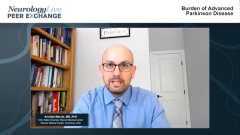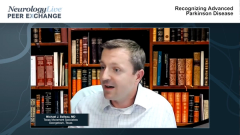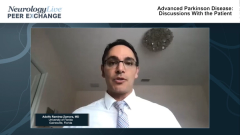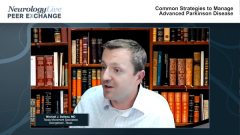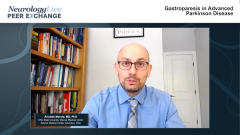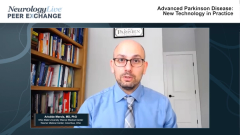
Common Strategies to Manage Advanced Parkinson Disease
Experts discuss different strategies to manage concerns relating to advanced Parkinson disease including patient education.
Episodes in this series

Adolfo Ramirez-Zamora, MD: Michael, what are the usual strategies [to manage Parkinson disease], and how do you manage patients that start having motor fluctuations? The biggest rumor in Parkinson disease literature is that levodopa causes motor fluctuations, and that they could be strong. Sometimes, it may take more than 1 or 2 discussions to convince patients that, as Ari said, this progression of disease severity and disease duration are important factors related to motor fluctuations. If you can quickly summarize some of the strategies that we have in the clinic to manage some of these concerns?
Michael J. Soileau, MD: Adolfo, you said earlier that it pays dividends to make sure that your patients are educated about what it means to be “off” and what it means to be “on”, and I could not agree more. How quickly the discussion goes from then on out with the patient depends on how much they understand about their Parkinson disease. I have, in every exam room, a graphic laminated on our desk that goes into the narrowing therapeutic window, or sweet spot, as I call it, from early Parkinson disease to advancing Parkinson disease, and how that narrows with time. If you’re above your sweet spot, your gas tank is overflowing. It’s just pouring out. That’s when you get dyskinetic. If you’re under your sweet spot, that’s when you’re stiff. You’re tremulous. You’re “off.” You feel horrible. To Ari’s point, all these nonmotor features, panic attacks and wearing off dystonia, and all kinds of things that happen that are miserable for these patients and really rob the control of their Parkinson disease. It steals that from them. So, if they understand that, then I try to express to them my whole job is to keep your dopamine levels not too high, not too low, but just right. To Ari’s point, keep it nice and steady. That’s what the brain should do anyway. So, we have to be very strategic.
I always try to start simply by just looking at the medications. The timing of when are they taking their medicine, and are they paying attention to the timing of the symptom that they’re complaining about. I tell this story about a patient of mine: I was the 5th neurologist that she’d seen, but only the 1st movement disorder specialist. She was so dyskinetic in my first exam with her that I thought she was going to hit her head on my wall and knock a hole in it. I mean, it was very impressive. Her alarm goes off in the middle of our encounter and she goes to take her levodopa. I asked, “Oh, wait, why are you taking your levodopa right now?” She said, “Well, it’s because I was told that timing is so important, and I must always take my medicine on time.” But in all those years, no one had stopped to explain that that is true except for when your dopamine levels are already high—you don’t want to add fuel to the fire. Literally just by changing the timing of her medicine and a little bit of the dose to try to prevent those peak-dose dyskinesia, for the first time in a long time she was able to enjoy fairly smooth motor symptoms. It was such a simple change, but conceptually it was something very important.
So I always like to start simple, if I may, and just make sure that the patient understands that concept. But then what to do when your medicine is not working well—that’s when we really excel at making sure that they’re on the right combination, or “recipe,” of medication, device-aided therapy, or the combo of both that can really achieve whatever it is that we’re trying to achieve for them. Notice I didn’t say motor fluctuation freedom. I said what it is that they’re wanting. So, if I can wave a magic wand and something gets better, whatever that would be, and the patient will usually say freezing— “I hate it when I freeze,” or “This panic feeling I get every three hours.”—as long as they recognize what that “off” symptom is, we can treat it very nicely. It’s just recognizing that and really educating those patients on that concept which I think is so important. And [educating] our staff members for that matter. When these patients call us, it’s important that [our staff] knows those questions to ask as well, so that we can accurately troubleshoot whatever it is the patient is complaining about.
Adolfo Ramirez-Zamora, MD: That’s a great discussion. I think that you touched on a couple of key points for this panel, including recognizing signs and symptoms because sometimes it may not be obvious, and also in utilizing therapy for each patient. You have to consider multiple things when you’re selecting what you think may be the best therapy for patients, and sometimes less is more. It’s not only about giving [patients] more and more medications.
Thank you all for watching this Neurology Live® Peer Exchange. If you enjoyed the content, please subscribe to our eNewsletter to receive upcoming peer exchanges and other great content right in your inbox. Thank you so much.
Transcript Edited for Clarity
Newsletter
Keep your finger on the pulse of neurology—subscribe to NeurologyLive for expert interviews, new data, and breakthrough treatment updates.

